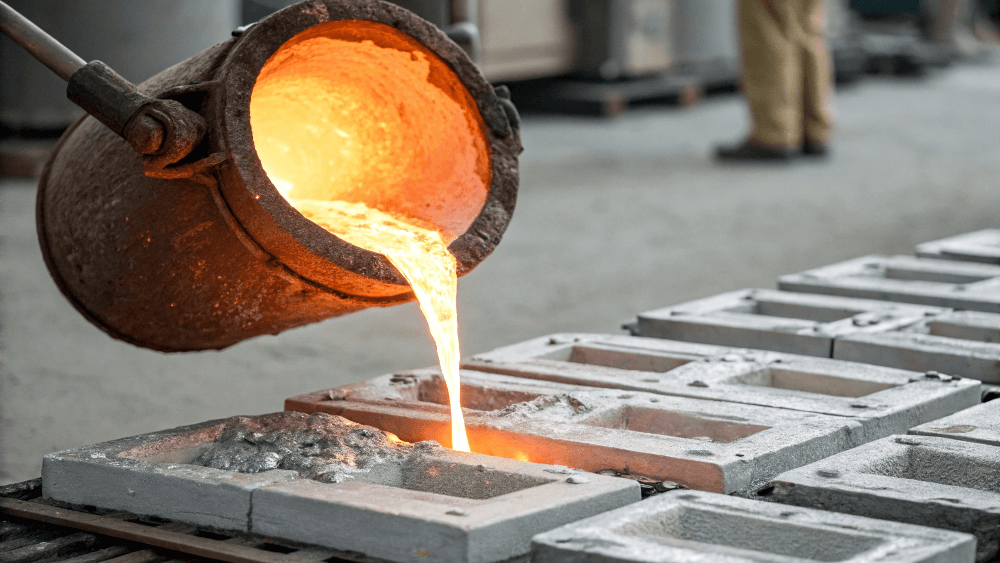How Aluminum Foundry Wisconsin is preferred by numerous companies in casting
Wiki Article
Just How Aluminum Foundry Adds To Improvements in Aerospace Design
Aluminum shops are essential to improvements in aerospace design. They produce light-weight, high-strength parts that are vital for modern airplane. Via sophisticated spreading strategies, these shops create complex geometries that enhance structural honesty. In addition, the development of remarkable Aluminum alloys supports the market's emphasis on gas performance and sustainability. Nonetheless, obstacles stay in the manufacturing process. Understanding these variables discloses the extensive influence of Aluminum on aviation's future.The Importance of Lightweight Products in Aerospace Layout
As the aerospace market remains to progress, the relevance of light-weight materials comes to be significantly evident. The demand for efficiency and sustainability drives designers to focus on the usage of products that minimize overall weight without endangering architectural honesty. Light-weight materials, especially Aluminum, play an important duty in boosting gas performance, improving payload ability, and increasing the overall performance of aircraft.The integration of these products enables for cutting-edge layouts, allowing makers to develop more aerodynamic forms that can hold up against severe problems. The decrease in weight not just lowers functional prices but also adds to a lowered environmental impact, straightening with global initiatives towards sustainability in aeronautics.
Advanced Casting Techniques in Aluminum Foundries
Advanced spreading strategies in Aluminum shops play an essential role in aerospace design by enabling the manufacturing of light-weight and specific elements. Developments in mold layout and precision casting procedures are important in accomplishing ideal efficiency and architectural honesty. In addition, the development of lightweight alloys enhances the overall performance and effectiveness of aerospace applications.Ingenious Mold Design
Cutting-edge mold style plays a necessary duty in the efficiency and performance of Aluminum shops, especially within the aerospace market. By leveraging sophisticated materials and methods, modern-day mold and mildews can be engineered to withstand heats and pressures, making certain peak performance throughout the casting procedure. These designs commonly integrate intricate geometries that enable the manufacturing of lightweight yet structurally audio parts, vital for aerospace applications. Additionally, using computer-aided layout (CAD) software application helps with accurate modeling, allowing factories to fine-tune and replicate mold styles before physical production begins. This not just boosts the high quality of cast components yet also reduces waste and lead times, bring about significant cost financial savings. In general, cutting-edge mold and mildew design is a keystone of development in Aluminum Foundry innovation for aerospace design.Precision Casting Processes
The performance of cutting-edge mold and mildew designs flawlessly integrates with precision spreading processes, which are necessary for generating premium Aluminum parts in aerospace design. These processes, including sand spreading, pass away spreading, and financial investment spreading, assure the development of complex geometries with limited tolerances. Advanced techniques like vacuum cleaner spreading and stress die casting boost the stability and surface finish of the last items. Precision casting decreases material waste while making best use of the mechanical residential or commercial properties of Aluminum, essential for aerospace applications. Additionally, using real-time monitoring and progressed simulation tools throughout the spreading procedure enables instant modifications, causing improved quality assurance. Collectively, these precision spreading processes setting Aluminum foundries at the center of aerospace innovation, supporting the industry's demand for reliability and performance.Light-weight Alloy Development
As aerospace designers look for to enhance gas performance and efficiency, lightweight alloy growth ends up being an essential focus in Aluminum foundries. These factories utilize sophisticated casting methods to develop alloys that give premium strength-to-weight proportions. Advancements in alloy composition, including the consolidation of elements like lithium and magnesium, enable the production of materials that withstand extreme problems while minimizing general aircraft weight. Strategies such as die casting and financial investment spreading promote the precision manufacturing of complicated forms, which are important for aerospace applications. Additionally, recurring research aims to optimize these alloys for boosted mechanical properties and increased longevity. By prioritizing lightweight alloy growth, Aluminum shops significantly contribute to the evolution of aerospace engineering, leading the means for extra sustainable and efficient aircraft layouts.
Enhancing Architectural Stability With Aluminum Parts
Aluminum components provide significant benefits in boosting architectural stability within aerospace design. Their lightweight nature adds to total performance while maintaining strength, which is crucial for aircraft performance. In addition, the stress and anxiety resistance buildings of Aluminum aid ensure the sturdiness and dependability of aerospace frameworks under different operational problems.
Lightweight Material Advantages
While conventional materials usually endanger weight for stamina, using Aluminum parts in aerospace design offers substantial advantages in architectural stability. Aluminum's lightweight nature adds to general style efficiency, permitting for more structured aircraft that eat much less fuel, thereby improving sustainability. The product's exceptional strength-to-weight proportion warranties that elements keep longevity without adding unneeded mass. This top quality promotes enhanced efficiency and agility in trip, along with enhanced payload abilities. Furthermore, Aluminum's resistance to corrosion extends the life expectancy of aerospace structures, decreasing upkeep prices and enhancing safety. As producers progressively embrace Aluminum alloys, the aerospace sector experiences a transformative change towards much more reliable and reliable design solutions that focus on both efficiency and environmental obligation.Anxiety Resistance Characteristics
Although numerous materials possess special residential properties, Aluminum's exceptional tension resistance stands apart as an essential variable in boosting the architectural honesty of aerospace parts. This resistance plays an essential role in ensuring that airplane can withstand different functional stresses, including tiredness, effect, and environmental problems. Aluminum alloys, specifically engineered for aerospace applications, show high tensile strength while keeping lightweight characteristics, making it possible for engineers to design extra efficient frameworks - Aluminum Foundry. In addition, the capacity of Aluminum see this page to withstand cyclic loading without considerable deformation contributes to the longevity and integrity of aerospace parts. As innovations proceed in Aluminum Foundry strategies, the development of stress-resistant Aluminum parts guarantees further renovations in efficiency, safety, and performance throughout the aerospace sector, solidifying Aluminum's duty as a recommended material in modern designGas Effectiveness Improvements Driven by Aluminum Innovations
As the aerospace market seeks to enhance gas effectiveness, ingenious uses Aluminum have actually arised as a crucial remedy. Aluminum's light-weight nature notably lowers airplane weight, enabling lower fuel intake during flight. This reduction in weight is essential, as even tiny decreases can bring about considerable renovations in overall gas economic climate.Advanced Aluminum alloys, designed for boosted stamina and toughness, enable suppliers to produce elements that maintain structural honesty while minimizing mass - Aluminum Foundry. In addition, the integration of Aluminum in airframes and engine elements facilitates enhanced the rules of aerodynamics, adding to decreased drag and boosted performance
The fostering of Aluminum in aerospace not only meets the demand for fuel-efficient design however additionally lines up with governing stress for lower discharges. As these innovations continue to advance, they play a considerable duty in establishing new criteria for gas efficiency, making certain that the aerospace sector can meet growing ecological and financial difficulties.

The Function of Aluminum in Sustainable Aeronautics Practices
The boosting emphasis on lasting aeronautics practices has placed Aluminum as a vital product in the quest for greener airplane design. Recognized for its light-weight homes, Aluminum significantly lowers airplane weight, bring about reduced fuel intake and discharges. Its recyclability further improves its sustainability profile, as Aluminum can be recycled indefinitely without loss of quality. This particular sustains a circular economic climate within the air travel industry, reducing waste and resource depletion.Innovations in Aluminum alloys have actually boosted their stamina and corrosion resistance, permitting for longer service life and reduced upkeep needs. These technologies assist in the development of extra efficient airplane frameworks, adding to overall sustainability efforts. Additionally, Aluminum's thermal conductivity plays an essential duty in energy-efficient layouts, improving systems such as warmth exchangers. Jointly, these attributes emphasize Aluminum's critical role beforehand lasting aviation, lining up with international efforts focused on decreasing the ecological influence of air travel.
Obstacles Faced by Aluminum Foundries in Aerospace Manufacturing
While Aluminum shops play an essential function in aerospace manufacturing, they deal with significant challenges that can influence manufacturing efficiency and quality. One major obstacle is the strict high quality control standards needed in the aerospace market. Any kind of flaw can jeopardize safety and efficiency, necessitating extensive assessment processes that extend production timelines. In addition, foundries often emulate changing resources prices, which can influence pricing and earnings. The intricacy of Aluminum alloys made use of in aerospace applications more complicates the manufacturing process, as accurate published here formulations are important for accomplishing wanted mechanical properties. Proficient labor scarcities hinder the ability to maintain top quality production degrees. Ultimately, ecological laws impose limitations on emissions and waste management, needing foundries to purchase sustainable practices, which can be cost-prohibitive. These elements collectively develop a landscape where Aluminum shops need to continually adjust to satisfy the evolving needs of aerospace manufacturing while ensuring safety and conformity.Future Patterns in Aluminum Applications for Aerospace Engineering
With innovations in technology and increasing demands for performance, the future of Aluminum applications in aerospace engineering is poised for significant improvement. The combination of ingenious Aluminum alloys and compounds is expected to improve strength-to-weight proportions, bring about even more fuel-efficient aircraft styles. In enhancement, developments in additive manufacturing methods will certainly permit the manufacturing of complicated Aluminum structures that were formerly impossible, enhancing efficiency and decreasing waste.
Sustainable practices will certainly play a necessary function, with an expanding emphasis on reusing Aluminum to minimize ecological influence. The aerospace market is likely to embrace smarter producing processes, such as automation and expert system, making sure better and accuracy in Aluminum elements. Furthermore, partnerships in between Aluminum factories and aerospace companies will certainly foster r & d, leading the way for new applications that satisfy the rigorous requirements of modern aerospace design - Aluminum Foundry. Generally, the future looks guaranteeing for Aluminum's role fit the skies
Regularly Asked Inquiries
What Are the Ecological Effects of Aluminum Production in Aerospace?
The environmental influences of Aluminum production in aerospace include considerable energy intake, greenhouse gas discharges, and habitat interruption. Additionally, mining processes can bring about dirt deterioration and water contamination, increasing issues about sustainability and ecological equilibrium.Just How Does Aluminum Contrast to Other Materials in Aerospace Applications?
Aluminum provides a special mix of lightweight residential properties, deterioration resistance, and cost-effectiveness compared to other products. Its high strength-to-weight proportion makes it specifically advantageous for aerospace applications, boosting gas effectiveness and general efficiency in aircraft design.What Certifications Do Aluminum Foundry Employees Requirement for Aerospace Projects?
Aluminum Foundry workers need specific training in metallurgy and casting strategies, together with knowledge of aerospace market requirements. Certifications in top quality control and security methods are also vital to ensure compliance with stringent aerospace job demands.Are There Any Type Of Safety Problems With Using Aluminum in Aerospace Engineering?
Safety and security issues regarding Aluminum in aerospace engineering consist of susceptibility to tiredness, stress and anxiety, and rust fractures. Appropriate therapy and alloy option are vital to reduce these risks, making certain architectural honesty and total security in aerospace applications.Just How Does Aluminum Recycling Advantage the Aerospace Sector?
Aluminum recycling significantly benefits the aerospace market by check here minimizing product prices, minimizing environmental influence, and preserving energy. This sustainable method boosts the sector's effectiveness while promoting making use of lightweight, high-performance components in aircraft manufacturing.Advanced casting methods in Aluminum shops play an essential role in aerospace engineering by enabling the production of lightweight and exact elements. Cutting-edge mold style plays an essential role in the performance and performance of Aluminum factories, specifically within the aerospace field. As aerospace designers look for to improve gas effectiveness and efficiency, light-weight alloy advancement becomes a necessary emphasis in Aluminum factories. Aluminum alloys, specifically crafted for aerospace applications, display high tensile toughness while preserving lightweight characteristics, making it possible for designers to design more reliable frameworks. Partnerships between Aluminum shops and aerospace firms will promote research study and development, leading the method for brand-new applications that fulfill the rigorous needs of modern-day aerospace design.
Report this wiki page